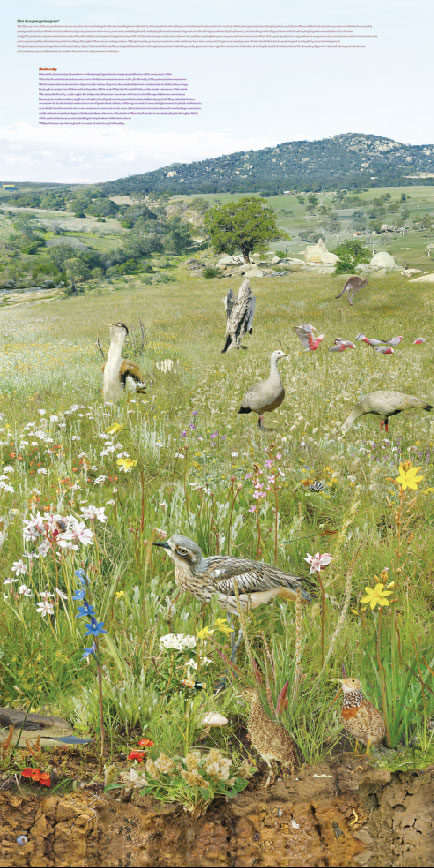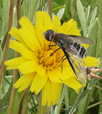
All images copyright© inherit earth
panel 8
What is being done?
Although there have been nature movements and an appreciation of Australian fauna and flora since European arrival, there was renewed focus on the fate of the grasslands of the Victorian Volcanic Plains in the 1980s, which was part of a growing sense of responsibility about the environment generally in Victoria. Scientific research was carried out by a number of environmentalists and ecologists into the grasslands and other threatened ecosystems in Victoria, which led to the creation of the Fauna and Flora Guarantee Act 1988. The first action under the Act was an interim conservation order to save the Golden Moth Orchid. Conferences and seminars were held to share the findings from research into grassland diversity. Various government departments such as the Department of Primary Industry (DPI) and the predecessor of the current Department of Sustainability and Environment (DSE), catchment management authorities and local councils began putting resources into conservation of this recently recognised natural heritage. The rise of many new Friends groups and Landcare also brought many people to focus on the many challenges facing the reclamation, restoration and conservation of what is now recognised as a unique and endangered ecosystem. Practical steps through Trust for Nature and other schemes saw both publicly and privately owned land being set aside for indigenous plants and animals. Continued research and the rise of newsletters such as the Grassy Groundcover Gazette from Greening Australia, Indigenotes from IFFA and numerous reports on government and municipal web sites have led to plenty of information about restoration being available to those who want to access it. Grassland plants and seeds have been collected, multiplied and promoted through a growing number of dedicated nurseries, and field trips are organised regularly for more and more people to become part of a growing group who are attempting to rescue something of our natural heritage.
What can you do?
What can we do to help conserve what is left of our unique grasslands, flowerlands, herblands or however we would describe them? We cannot restore the plains to the original magnificent and complex garden they were when Europeans first arrived here. Furthermore much of the agriculture on the plains feeds and clothes us and contributes to our comfort and wealth through exports and trade. The expansion of the housing developments into the plains in the western and northern suburbs seems inevitable and difficult to slow down. Ideally the restoration of what can be reclaimed could be done in co-existence with the farms and other rural industries of the Volcanic Plains, and the housing developments spreading out from Melbourne’s fringe. The first thing people can do is to learn and appreciate something of the local indigenous plants and the habitat they grow in. The simplest practical action would be to add some local plants to your garden. Seek out nurseries that carry local plant stock and add native plants that will do well in locations that parallel their natural habitat. Why not investigate friends groups in your area. Attend a seminar or lecture on indigenous plants and animals in your region. Ask the teachers at your child’s school if they are looking at the local environment. Look up websites on local conservation issues, including what your local municipal council or shire is doing. Find out where your local wildflowers grow, and what animals are still around. We can continue to make ourselves more familiar with the history of the local landscape and environment. The very act of learning something about this unique ecosystem will introduce us to new potential treasures that could be in our own backyard, over the fence or down the street. There are many knowledgeable people within places like DSE, DPI, catchment management authorities, local councils and friends and Landcare groups with information about these issues which is readily available.
Myrnong (yam daisy)
The Myrnong or Yam Daisy was a staple food of the Aboriginal tribes of the plains. More like a radish than a potato it had a sweet coconut-like taste and was cultivated in small plots of up to five acres. Aboriginal women used sticks to dig up and separate the tuber-like roots and aerate the soil. They would often leave part of the roots for new growth. They used similar practices for a range of other plants, particularly daisies, orchids, Milkmaids and lilies such as the Chocolate Lily and the Bulbine Lily. ‘…in many places the ground was quite yellow with the flowers of the cichoraceous plant Tao, whose root, small as it is, constitutes the food of the native women and children’ Major Thomas Mitchell, 1836, observing the Myrnong plants or yam daisies that once covered the plains in their millions.
